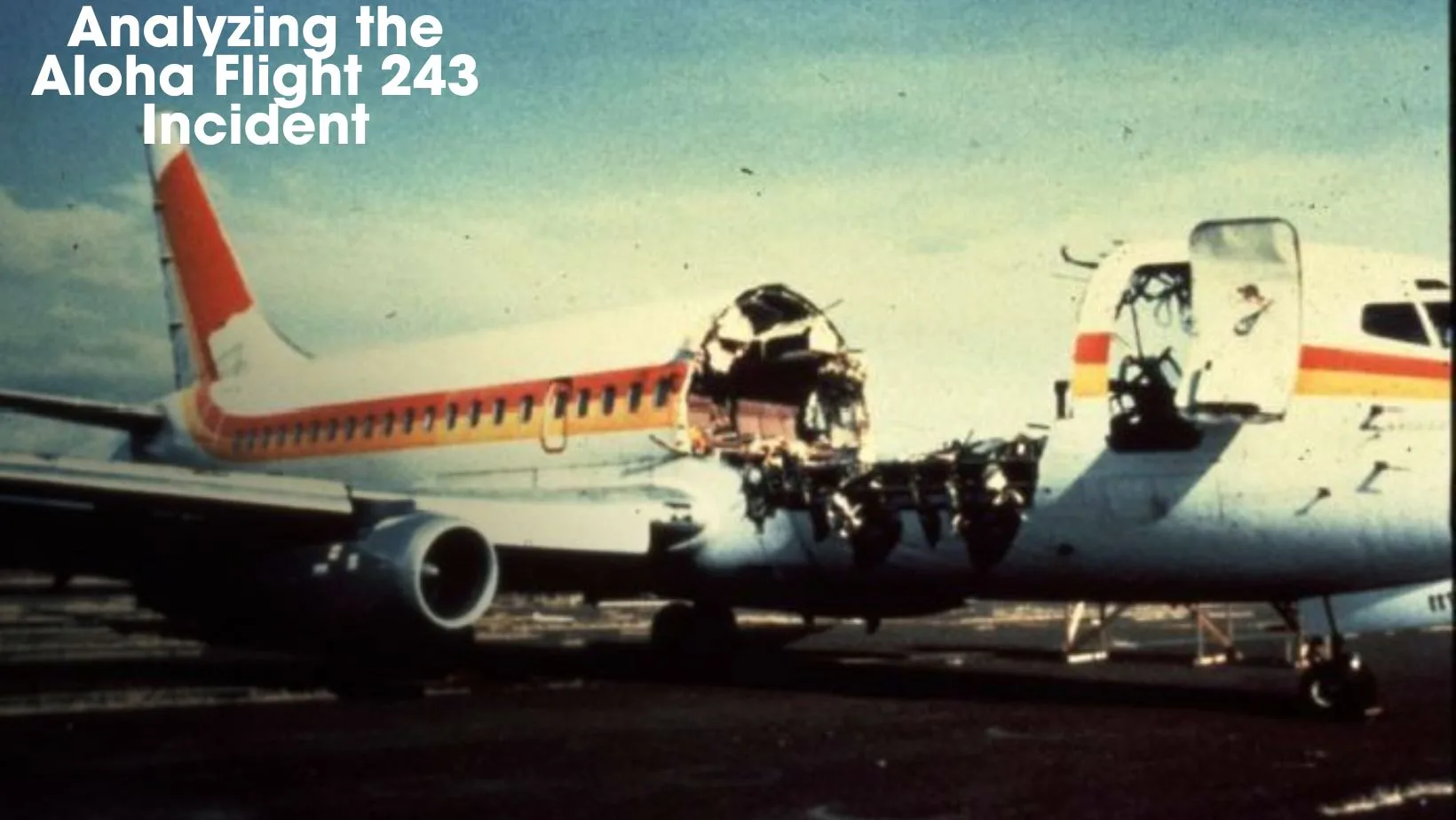Brief Overview of Aloha Airlines and Flight 243
Aloha Airlines Flight 243 was a flight that followed a regular schedule and flew between the cities of Hilo and Honolulu in the state of Hawaii. On April 28, 1988, an incident occurred that resulted in significant damage to the Boeing 737-297 aircraft. The incident was caused by a sudden explosive decompression during the flight, which was attributed to the failure of a section of the fuselage. Subsequent investigation determined that the failure was attributed to a combination of inadequate maintenance procedures and the occurrence of metal fatigue. The structural damage to the aircraft was extensive, leading to a dramatic and hazardous situation for the crew and passengers. This event highlighted the importance of proper maintenance procedures and raised awareness about the potential dangers of metal fatigue in aircraft structures.
History and services of Aloha Airlines
Aloha was initially founded as Trans-Pacific Airlines in 1946, aiming to compete with Hawaiian Airlines. The airline began operations with a single aircraft and quickly gained popularity, earning the nickname “The Aloha Airline.” It officially became Aloha Airlines in 1958.
Over the years, the airline faced challenges, including market competition, rising costs, and external events like the 9/11 attacks and fuel price increases. The airline faced financial difficulties and sought bankruptcy protection on two occasions, once in 2004 and again in 2008. Despite efforts to stay afloat, Aloha Airlines suspended all passenger flights in March 2008, leading to employee layoffs. The company’s profitable cargo and contract services division was sold to Saltchuk Resources, an existing player in the Hawaiian market.
The Incident: Flight 243
Pre-Flight Operations and Initial Flights
Before delving into the incident itself, it is important to understand the context in which it took place. Aloha Flight 243 was a Boeing 737 aircraft that embarked on a series of flights on that fateful day. The first officer conducted the pre-flight checks, including weather conditions and inspections of the aircraft. However, it is worth noting that at the time, pilots were not required to inspect the aircraft between each flight, only in the morning.
After three uneventful round-trip flights, it was time for a crew change. Despite the absence of an external inspection, Captain Rob Schoensteiner and First Officer Madeleine Tomkins proceeded with their next flights to Maui and then to Hilo. The third flight, Flight 243, turned out to be the flight where the incident occurred.
Incident Details: Date, Time, and Location
On the 28th of April 1988, at 1:25 PM, Hilo International Airport saw the departure of Aloha Airlines Flight 243. The aircraft had already completed three uneventful round-trip flights earlier that day. Before departure, the pre-flight inspection did not reveal any abnormalities, and there were no weather advisories for the planned route.
miles south-southeast of Kahului, Maui. It was at this moment that a section on the left side of the aircraft’s roof ruptured with a distinct “whooshing” sound. The aircraft’s captain detected a rolling motion and encountered instability, while the first officer observed airborne fragments of gray insulation within the cockpit. The cockpit door broke away, exposing an open view where the first-class ceiling had once been.
The extent of the damage was substantial, as a large portion of the roof—approximately 18 feet in length—had torn off from behind the cockpit to the fore-wing area. These events occurred during the flight at an altitude of 24,000 feet (7,300 m), disrupting the normal operation of the aircraft and creating a hazardous situation for those on board.
Description of the aircraft involved
The aircraft involved in the incident was a Boeing 737-200, specifically the 152nd airframe produced at the Renton assembly plant. It was delivered to Aloha Airlines as a new aircraft in 1969 with the registration N73711. Throughout its service, the aircraft accumulated 35,496 flight hours and nearly 90,000 flight cycles, which exceeded the intended design limits.
Overview of the flight crew and passengers
At the time of the incident, Aloha Airlines operated two of the highest flight-cycle Boeing 737s worldwide, with five crew members and 89 passengers on board, bound for Honolulu. Captain Robert Schornstheimer, with 8,500 flight hours and extensive experience on Boeing 737s, served as the flight’s captain, while First Officer Madeline “Mimi” Tompkins, with 3,500 hours on the Boeing 737, was the co-pilot.
The Sequence of Events and Causes
The Incident Unfolds
At precisely 1:25 p.m. on a regular Thursday, Aloha Airlines Flight 243 began its trip from Hilo to Honolulu. The first part of the flight was uneventful as passengers settled into their seats, doing their things like reading, working, or simply trying to relax.
Flight 243 comprised two pilots in the cockpit and three cabin crew members, along with 89 passengers. The flight was taking place under clear and pleasant weather conditions over the Hawaiian Peninsula. First Officer Madeleine was the pilot flying the aircraft. Shortly after takeoff from Hilo, as the aircraft leveled off at 24,000 feet, a loud tearing sound echoed throughout the plane.
The force of the explosive decompression caused Madeleine’s head to be pulled back, and she witnessed insulation and debris swirling inside the cockpit. Captain Rob, upon observing the missing cockpit door and the exposed sky where the roof should have been, immediately realized the severity of the situation. It was evident that a significant structural malfunction had occurred.
Unapprehended by the pilots, a sudden and significant change in pressure occurred. This caused the floor of the plane to rise, breaking several floor beams and damaging the cable connecting to the left engine. As a result, the aircraft started rocking violently from side to side, presenting a challenging situation for the pilots, Schornstheimer and Tompkins.
Crew Response and Emergency Descent
In the face of such a catastrophic event, the flight crew followed established protocols. Captain Schornstheimer initiated the emergency descent, while Madeleine swapped roles and took over as the flying pilot. Communication, however, became extremely challenging due to the overwhelming noise caused by the structural damage.
Despite the communication difficulties, the crew managed to activate the emergency code 7700 on the transponder, alerting air traffic controllers of their dire situation. As they descended to approximately 14,000 feet, the noise level decreased, enabling improved communication with air traffic control.
Realizing the extensive damage, he decided against attempting to restore the cabin’s pressure, understanding it would be futile and potentially risky. Managing the aircraft became even more difficult as it was now flying faster than usual, around 170 knots, or just over 195 mph. Previous attempts to slow down the plane had only intensified the violent shaking.
Diversion to Maui and Landing Preparations
With the situation still critical, the decision was made to divert the aircraft to Maui. The crew informed ATC about the emergency and requested immediate assistance. However, there was initial confusion regarding the severity of the problem, leading to the deployment of firefighting crews instead of ambulances.
As the aircraft approached the runway in Maui, the crew prepared for landing. Given the extent of the structural damage, there were concerns about how the aircraft would respond to configuration changes. The captain reduced the speed to 210 knots below 10,000 feet, resulting in a significant decrease in ambient noise. The crew decided to maintain a speed of 170 knots and set the flaps to 5, which improved control.
Challenges during Landing
During the landing preparations, an issue with the nose gear arose. While the main gear displayed green indications, there was no confirmation of the nose gear being down and locked. The crew performed the emergency gear extension procedure, but it failed to provide any indication of the nose gear’s status. This information was immediately relayed to air traffic control.
Approaching the runway, the captain increased engine thrust to stabilize the aircraft on the glide slope. However, he encountered a yaw and discovered that the left-hand engine did not respond to throttle inputs. Despite these challenges, the captain safely landed the aircraft on runway 02 in Maui at 1:58 pm.
Finally, the plane landed tensely on the runway of Kahului Airport, with the front landing gear lowered. However, the danger was not yet over. As the aircraft rescue firefighters hurried to the scene, a makeshift area was quickly set up near the plane to provide immediate medical care to any passengers or crew members who may have been injured.
Rescue, Firefighting, and Ambulance Response
The fire department at Maui Airport quickly responded to an emergency involving an airplane. They arrived with five emergency vehicles to assist. The passengers who were able to walk exited the plane using slides and the rear airstair. Once it was safe, the fire department personnel entered the airplane to help the injured passengers who were still on board. Within 25 minutes, all the occupants were successfully evacuated from the plane.
Initially, the flight crew informed the air traffic control (ATC) that there was a “rapid decompression” situation. However, they did not provide specific details about how much structural damage they got. The ATC promptly alerted the rescue and firefighting teams but did not immediately request ambulance assistance. Later, at 13:53, the flight crew confirmed their need for passenger assistance upon landing. The ATC personnel acknowledged this request. According to records from the police dispatcher, the “Medic I” ambulance was notified at 13:58, around the same time the aircraft touched down. The reason for the delay in notifying the ambulance is unknown. The first ambulance reached the scene at 14:05 and called for additional help.
Investigation and Contributing Factors
National Transportation Safety Board (NTSB)
According to the report, the accident was most likely caused by a failure in the maintenance program of Aloha Airlines, the operator of the aircraft. The maintenance program did not detect significant fatigue and dis-bonding damage on the airplane, specifically in the fuselage. This damage eventually led to the separation of the upper lobe of the fuselage and the failure of the lap joint known as S-10L.
The management of Aloha Airlines also shared responsibility for the accident. They failed to properly supervise the maintenance personnel working for the airline, which could have helped identify and address the issues with the aircraft before the accident occurred.
Federal Aviation Administration (FAA) Role in Investigation
Additionally, the Federal Aviation Administration (FAA) played a role in the accident. They demanded an inspection through Airworthiness Directive 87-21-08, which would have required the inspection of the flap joints by Boeing Alert Service Bulletin SB 737-53A1039. However, this directive was not fully implemented, contributing to the failure to detect the existing problems with the lap joint.
The accident was also a result of shortcomings in the design and production of the Boeing 737 aircraft. The production process for the cold bond lap joint, a crucial component that holds the fuselage together, faced difficulties and resulted in corrosion, premature fatigue cracking, and weak bonding. The FAA did not enforce stricter requirements for the production of the lap joint, and Boeing did not take appropriate action to halt production despite the known issues. The engineering design itself lacked consideration for continuous inspection of the 737’s integrity.
Normally, the design of the 737 aircraft allows it to decompress safely even with a significant crack in the aircraft’s skin, up to 40 inches in length. The crack is designed to release internal pressure, preventing explosive decompression. However, in this case, the fuselage tore apart over a length of approximately 18 feet. This indicates the presence of numerous fatigue-induced cracks that went undetected. The fuselage had weakened over time due to the age and continuous use of the airplane. The adhesive intended to hold the lap joint together failed to prevent water from seeping between the metal sheets, causing corrosion and further weakening the joint.
Changes in aircraft inspection and maintenance regulations
The accident had a significant impact on the maintenance practices for older aircraft. It became evident that old airplanes are not safe to fly, even with regular maintenance. As a result, the airline involved in the accident, Aloha Airlines, no longer uses the specific model of aircraft, the 737-200 ‘basic,’ that was involved in the incident. Instead, they have transitioned to using the 737-200 ‘advanced,’ which has a different manufacturing process and is considered safer.
Following the accident, the Federal Aviation Administration (FAA) took action to implement more rigorous inspection programs for aging planes. They recognized the importance of the human aspect in carrier maintenance and inspection. This led to the requirement for well-trained maintenance personnel and supervisors who undergo certification, including comprehensive training in repair procedures. The FAA also emphasized the need for inspectors and mechanics to have unquestionable qualifications.
In 1989, the FAA conducted a review of the regulations (25.571) to assess the retroactive requirements for both old and newly certified aircraft. This was done to ensure that safety measures were in place for older planes and new aircraft entering service. It is worth noting that the two pilots involved in the accident were not disqualified and continued to work for the airline until the company ceased passenger operations.
Legal and Financial Consequences
Following the accident, the survivors of the incident and the families of the victims decided to take legal action against both Aloha Airlines and the manufacturer of the aircraft. The objective of these lawsuits was to seek compensation for the physical and emotional harm inflicted by the tragic event.
Overview of injuries sustained by passengers and crew
The emotional consequences of the accident had a profound and enduring effect on both the passengers and the crew members who were aboard Aloha Airlines Flight 243. Many individuals experienced significant difficulties in recovering from the traumatic experience and were diagnosed with post-traumatic stress disorder (PTSD). Overcoming the emotional trauma posed considerable challenges for them.
Lesson from Aloha Airline 243
The survival of Aloha Airlines Flight 243, which experienced a fuselage rupture over Hawaii, served as a wake-up call for the air transport industry. Despite only one fatality, the accident exposed long-standing issues and highlighted the dangers of complacency. The investigation revealed that the factors leading to the accident were well-known but had been neglected. The incident emphasized the need for significant improvements in airline practices and regulatory oversight. The industry had become complacent about maintenance and the durability of aging aircraft, disregarding known vulnerabilities in the fuselage design. The accident prompted a reevaluation of inspection procedures, the implementation of mandatory corrosion control programs, and a focus on proper repairs and maintenance. The lesson learned was that safety should never be taken for granted, and continuous effort is required to uphold the industry’s safety record.
Conclusion
The Aloha Flight 243 incident serves as a significant case study in aviation safety. It highlights the importance of meticulous inspections, especially for aging aircraft, and the need to promptly address any potential structural vulnerabilities. The actions taken by the flight crew in response to the explosive decompression and their successful landing under challenging circumstances are commendable. Through a comprehensive investigation, the NTSB shed light on the underlying causes of the structural failure, prompting improvements in aircraft manufacturing processes and maintenance procedures. By sharing this detailed account of the incident, we aim to honor the memory of those involved and contribute to the ongoing pursuit of aviation safety.
In summary, the airplane accident was primarily caused by the failure of Aloha Airlines’ maintenance program to identify and address structural damage in the aircraft. Inadequate supervision by the airline’s management, the FAA’s incomplete implementation of inspection directives, and deficiencies in the design and production of the Boeing 737 aircraft also contributed to the tragic event.







Leave a Reply